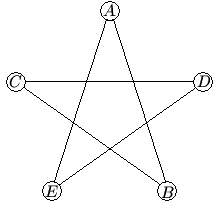Difference between revisions of "2005 AMC 10A Problems/Problem 17"
m (added category) |
(added diagram) |
||
| Line 1: | Line 1: | ||
==Problem== | ==Problem== | ||
In the five-sided star shown, the letters <math>A</math>, <math>B</math>, <math>C</math>, <math>D</math>, and <math>E</math> are replaced by the numbers <math>3</math>, <math>5</math>, <math>6</math>, <math>7</math>, and <math>9</math>, although not necessarily in this order. The sums of the numbers at the ends of the line segments <math>AB</math>, <math>BC</math>, <math>CD</math>, <math>DE</math>, and <math>EA</math> form an arithmetic sequence, although not necessarily in this order. What is the middle term of the sequence? | In the five-sided star shown, the letters <math>A</math>, <math>B</math>, <math>C</math>, <math>D</math>, and <math>E</math> are replaced by the numbers <math>3</math>, <math>5</math>, <math>6</math>, <math>7</math>, and <math>9</math>, although not necessarily in this order. The sums of the numbers at the ends of the line segments <math>AB</math>, <math>BC</math>, <math>CD</math>, <math>DE</math>, and <math>EA</math> form an arithmetic sequence, although not necessarily in this order. What is the middle term of the sequence? | ||
| + | |||
| + | [[Image:2005amc10a17.gif]] | ||
<math> \mathrm{(A) \ } 9\qquad \mathrm{(B) \ } 10\qquad \mathrm{(C) \ } 11\qquad \mathrm{(D) \ } 12\qquad \mathrm{(E) \ } 13 </math> | <math> \mathrm{(A) \ } 9\qquad \mathrm{(B) \ } 10\qquad \mathrm{(C) \ } 11\qquad \mathrm{(D) \ } 12\qquad \mathrm{(E) \ } 13 </math> | ||
Revision as of 17:40, 4 August 2006
Problem
In the five-sided star shown, the letters ![]() ,
, ![]() ,
, ![]() ,
, ![]() , and
, and ![]() are replaced by the numbers
are replaced by the numbers ![]() ,
, ![]() ,
, ![]() ,
, ![]() , and
, and ![]() , although not necessarily in this order. The sums of the numbers at the ends of the line segments
, although not necessarily in this order. The sums of the numbers at the ends of the line segments ![]() ,
, ![]() ,
, ![]() ,
, ![]() , and
, and ![]() form an arithmetic sequence, although not necessarily in this order. What is the middle term of the sequence?
form an arithmetic sequence, although not necessarily in this order. What is the middle term of the sequence?
![]()
Solution
Since each number is part of ![]() numbers in the arithmetic sequence, the sum of the arithmetic sequence is
numbers in the arithmetic sequence, the sum of the arithmetic sequence is ![]()
Since the middle term in an arithmetic sequence is the average of the terms, the middle number is ![]()










